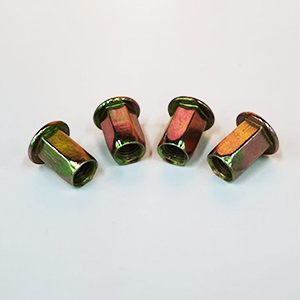Blind riveting means that during the riveting process, the riveted parts undergo plastic deformation under the effect of external tension. The deformation position is usually at a specially designed position, and the base material is clamped by the deformed part to achieve a reliable connection. Commonly used blind rivet nuts are This riveting method is used to complete the connection with the base material.
The purpose of blind rivet nuts: When the space inside the product is small and the nuts need to be installed outside, the riveting machine cannot perform riveting. At this time, pressure riveting and expansion riveting will not work, so blind rivets are needed. Suitable for all kinds of plates In the field of fastening, one-time riveting with a riveting gun can make up for the shortcomings of welded nuts.
How to install blind rivet nuts
The blind rivet nut is riveted by using a rivet gun. Then it is suitable to be used in places where it is not easy to rivet, such as square tubes and round tubes. The blind rivet nut also makes up for some shortcomings of electric welding. For example, in terms of aesthetics, there are also areas that are difficult to weld, such as thin plates.
Precautions for using blind rivet nuts
1. Check whether the gun nozzle screw is installed with the correct rivet nut standard. Select the corresponding gun head and rivet bolt, and the connecting parts are firm.
2. Pay attention to the deformation length or displacement of the riveted nut, and then adjust the operating rod angle correctly.
3. The scale ring of the rivet nut gun is used to adjust the riveting stroke. It can be adjusted according to needs during operation. It is worth noting that when adjusting the length of the riveting bolt, you need to open the 2 handles and adjust the gun head sleeve. The exposed length of the rivet bolt can be slightly longer than the length of the rivet nut. Finally, tighten the adjusting nut and the gun body together.
4. Finally, open both hands and pull out all the bakelite, put the corresponding rivet nut on the end of the rivet bolt and pinch it firmly. Push the bakelite to screw on the gun head bolt, and then insert the rivet nut into the rivet to be pre-drilled. hole, and then press the two handles together hard. At this time, the rivet nut expands to rivet the workpiece tightly. Then pull out the bakelite ball, and the blind rivet bolt will withdraw from the threaded hole. The installation of the blind rivet nut can be completed.

Related News
- Types of wire drawing rivets and anti-rust methods
- What are the functions of rivets?
- How to use blind rivets
- What is a rivet nut?
- Structure introduction and maintenance of rivet gun
- Application of Lantern Rivet Nut
- Classification and application of rivet standoffs
- The working principle and selection rules of riveting gun
- The use of rivet nuts
- Comparison of drawing rivet connection and traditional craftsmanship
- Introduction to the knowledge of lantern rivets
- Some precautions when using ring groove rivets
- Advantages of ring groove rivets
- Common knowledge about ring groove rivets
- Analysis of the basic principles of rivets
- Where do blind rivets need to be used?
- Solutions to the problem of Haima rivet caps falling off in the machinery industry
- Common knowledge about ring groove rivets
- How to use blind rivet nuts? You will know after reading this



